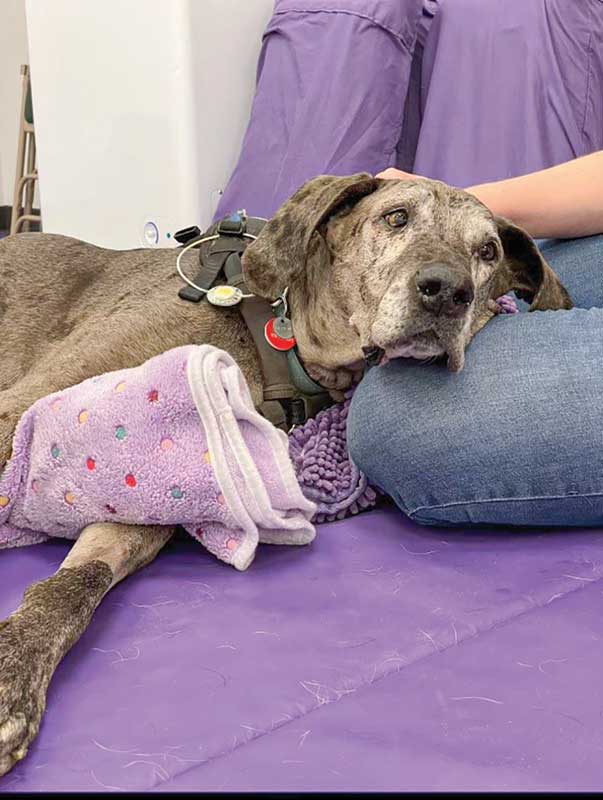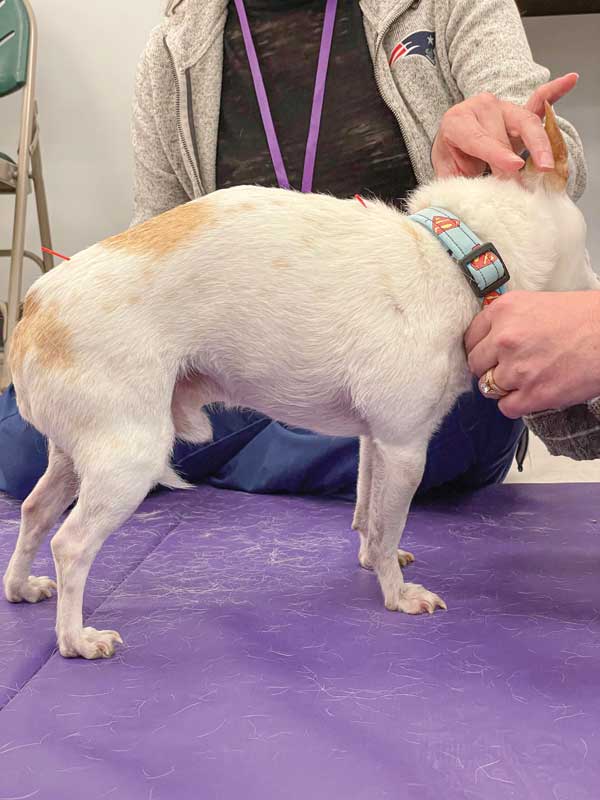Staffing shortages, provider burnout, and rising costs have caused many veterinarians to leave the profession, creating a gap in care. Who is eager to fill it? Apparently, human chiropractors. In addition to applying pressure to state agencies for direct access to animals, animal chiropractors are flooding portions of the internet with videos of their adjustments. Many depict vigorous techniques performed on animals that vocalize, struggle, bite, or try to get away. The person performing the technique may indeed be licensed to practice on humans, but laws vary about whether a Doctor of Chiropractic (DC) may lawfully “adjust” an animal. Regulations notwithstanding, they typically profess a love for animals, an unmet need for their services, and a contingent of grateful clients who sought their services because nothing else worked.1

Who can do it?
In one of the most extreme portrayals of this situation, chiropractor Doug Willen, DC, has attracted hundreds of thousands of followers with a YouTube channel called “Animal Cracker.”2 For many of us, the videos are hard to watch, and even veterinarians certified in manipulative techniques have expressed concern about what they see.3
Some claim instrument adjusting should never be performed on an animal because of risk of injury, while others trained by different programs may rely solely on a hand-held device.4 However, what constitutes an “adjustment,” based on positioning, force, speed, and delivery mechanism, varies widely, even for humans. Having human-trained practitioners applying human-oriented techniques to species of all types makes the establishment of safety guidelines and treatment parameters nearly impossible.
In a recent piece by Inside Edition on Dr. Willen’s animal practice, the reporter asked him, point blank, how he responds to critics who consider what he is doing to be animal abuse.5 Willen replied, “People are entitled to their opinion, but they should also understand that my teachers are veterinarians, so I studied directly under the supervision of veterinarian doctors that taught me everything that I am doing today with my work with animals.”6
Nevertheless, “learning” from veterinarians and then applying chiropractic techniques to animals without actually becoming a licensed veterinarian does not satisfy requirements put forth by the state of New York to adjust animals. In other words, Willen’s New York chiropractic license to practice on people does not extend to non-human animals.
Is it lawful?
The New York State Education Department (NYSED) website specifically states, “New York State Education Law, section 6551(1) defines the practice of chiropractic as detecting and correcting by manual or mechanical means structural imbalance, distortion, or subluxations in the human body for the purpose of removing nerve interference and the effects thereof, where such interference is the result of or related to distortion, misalignment or subluxation of or in the vertebral column.”7
It continues, “Therefore, as a New York State licensed chiropractor, you are practicing beyond the lawful scope of chiropractic if you provide professional services, treat, or correct structural imbalance, distortion, or subluxations for the purpose of removing nerve interference in any living creature, other than a human being.”
Per NYSED, “While there are postgraduate courses available to chiropractors for the study of animal anatomy and associated adjustive techniques, and there is a national organization dedicated to veterinary chiropractic, you should be aware that providing chiropractic care to animals is against the law. Also, even if a service is provided pro bono, i.e. without fee, you are accountable under the law. If someone requests you to help an animal, refer that person to a qualified veterinarian, some of whom are trained in adjustive techniques.”
The NYSED restrictions have not stopped Willen. He has posted hundreds of videos of his work on animals large and small, domestic, and exotic. He claims he has a six-month waiting list, charges $200 per treatment, and is board-certified by the American Veterinary Chiropractic Association (AVCA), which also employs the term “American Chiropractic Certification Commission”.8
Who regulates it?
The thing is, the AVCA does not provide board certification in chiropractic. Still, it does list 13 reasons “why ACCC/AVCA Certification Is Desirable” on its site.9 Of note, the AVCA says that it “promotes the highest standards of competence and safety in animal chiropractic care for the protection and benefit of the patient as well as the public” and “AVCA certified doctors are required to practice within the laws and regulations of their state/provincial licensure boards.”
One might ask how the AVCA reconciles its statements above with what is happening in “real life.” Even Dr. Willen does not dispute that he is practicing on animals without a veterinary license in New York. Further, one might be curious about the short- and long-term outcomes for animals receiving chiropractic treatments, in that courses have taught these treatments for decades, but no studies exist on the safety of animal chiropractic.
One veterinary neurologist, James Cellini, DVM, DACVIM (Neurology), has spoken out vehemently to the “Animal Cracker” videos published by Doug Willen on YouTube. Dr. Cellini writes, “I came across a channel from an animal chiropractor called “The Animal Cracker” recently and I wanted to give my thoughts in regards to this video, the comments made therein by the chiropractor and owner, and animal chiropractic in general. In summary, there is no evidence that supports the use of chiropractic in animals. The claims made by chiropractors and those who support chiropractic, are unfounded by evidence, anatomy, physiology, and simply logic.
“It is my strong belief they operate purely by grifting onto the phenomenon of placebo and various forms of bias. Further, from what I have seen on social media, animals are put through manual manipulations that cause pain and based on the various possible causes of their symptoms to begin with, should not be doing these movements for fear of worsening their neurologic deficits or pain level. In addition, these animals rarely, if ever, have an actual diagnosis the chiropractor is working from in the first place,” he concludes.10

What are the indications for animal chiropractic?
Lists appear on websites of the AVCA,11 veterinary schools,12,13 and at least one large veterinary corporation.14 The AVCA includes: “Neck, back, leg, and tail pain; muscle spasms and nerve problems; injuries from slips, falls, and accidents; jaw or TMJ problems, difficulty chewing; event or sports injuries; post-surgical care; bowel, bladder, and internal medicine disorders; maintenance of joint and spinal health; healing/helping with chronic internal medicine disorders; lameness, trouble getting up and down, athletic competitions; surgery involving anesthesia, seizures or neurological problems, recovery from illness or injury; geriatric household pet, behavior or mood change”; signs of navicular disease or laminitis in horses; and chronic health problems that do not resolve as expected.”

Essentially, could any disturbance, mental or physical, be a call for chiropractic? If so, surely evidence must exist to support these recommendations, yes?
No. A systematic review of mobilization and manipulative techniques applied to animals published in 2021 was done to “identify the clinical indications, dosages, outcome parameters, and efficacy of mobilization and manipulation techniques in dogs and horses.”15 The results? “Fourteen articles were included in this review of which 13 were equine and one was a canine study. There was a large variability in the quality of evidence that supports the use of joint mobilization or manipulation in treating pain, stiffness, and muscle hypertonicity in horses. Therefore, it was difficult to draw firm conclusions despite all studies reporting positive effects. Future studies need to establish standardized methods to evaluate the optimal dosages of mobilization and manipulation for use in animals.”
So, here we are, and here we remain, knowing little about what outcomes to expect and what types of injuries might result. When animal chiropractors come to your state and gain direct access to animals, even without a veterinary diagnosis beforehand, will you take action or just watch it unfold? In the meantime, when they contact you and request supervision, what will this mean for your patients, your practice, and your license if something
goes awry?
Narda G. Robinson, DO, DVM, MS, FAAMA, practices osteopathic medicine and veterinary medicine. Dr. Robinson taught science-based integrative medicine at the Colorado State University College of Veterinary Medicine and Biomedical Sciences for 20 years. In 2016, Robinson established her own academy in Fort Collins, Colo., where she teaches medical acupuncture, integrative rehabilitation, medical massage, and other integrative medical approaches. Columnists’ opinions do not necessarily reflect those of Veterinary Practice News.
References
- Animal Cracker: Dr. Doug Willen. https://www.youtube.com/c/AnimalCrackerDrDougWillen 2. YouTube Channel, Animal Cracker: Dr. Doug Willen. Accessed at https://www.youtube.com/@AnimalCrackerDrDougWillen on March 4, 2024.
- Personal communication with veterinarians, February – March, 2024.
- VOM (Veterinary Orthopedic Manipulation) Technology website. Accessed at https://vomtech.com on March 4, 2024.
- Inside Edition. Would You Take Your Pet to a Chiropractor? https://www.youtube.com/watch?v=3EG52ar3rzg
- Inside Edition YouTube Channel. Would You Take Your Pet to a Chiropractor? https://www.youtube.com/watch?v=3EG52ar3rzg. Transcript accessed on March 4, 2024.
- NYSED Office of the Professions Website. Chiropractic Care and Animals. Accessed at https://www.op.nysed.gov/professions/chiropractic/practice-alerts/chiropractic-care-and-animals#:~:text=Therefore%2C%20as%20a%20New%20York,other%20than%20a%20human%20being. On March 3, 2024.
- American Veterinary Chiropractic Association Website. Animal Chiropractic Certification Commission (ACCC) https://www.animalchiropractic.org/certification/ Accessed on March 3, 2024.
- American Veterinary Chiropractic Association Website. Why ACCC/AVCA Certification is Desirable. https://www.animalchiropractic.org/certification/ Accessed on March 3, 2024.
- DVMCellini. Vet Neurologist Reacts to Animal Chiropractor. https://www.youtube.com/watch?v=iJ_d8gI0uMA Accessed on March 4, 2024.
- American Veterinary Chiropractic Association Website. Why Animal Chiropractic? and Indications for Care. Accessed at https://www.animalchiropractic.org/find-a-doctor/ on March 3, 2024.
- University of Illinois College of Veterinary Medicine website. Chiropractic Adjustment for Animals. August 12, 2020. Accessed at https://vetmed.illinois.edu/pet-health-columns/chiropractic-adjustment-animals/ on March 3, 2024.
- Virginia-Maryland College of Veterinary Medicine website. Chiropractic. Accessed on March 3, 2024 at https://vth.vetmed.vt.edu/large-animal-services/equine-services/equine-chiropractic.html
- Marsden S, Messonier S, and Yuill C. Veterinary chiropractic care. VCA Canada website. Accessed on March 3, 2024 at https://vcacanada.com/know-your-pet/veterinary-chiropractic-care and https://vcahospitals.com/know-your-pet/veterinary-chiropractic-care
- Haussler KK, Hesbach AL, Romano L, et al. A systematic review of musculoskeletal mobilization and manipulation techniques used in veterinary medicine. Animals (Basel). 2021;11(10):2787.
